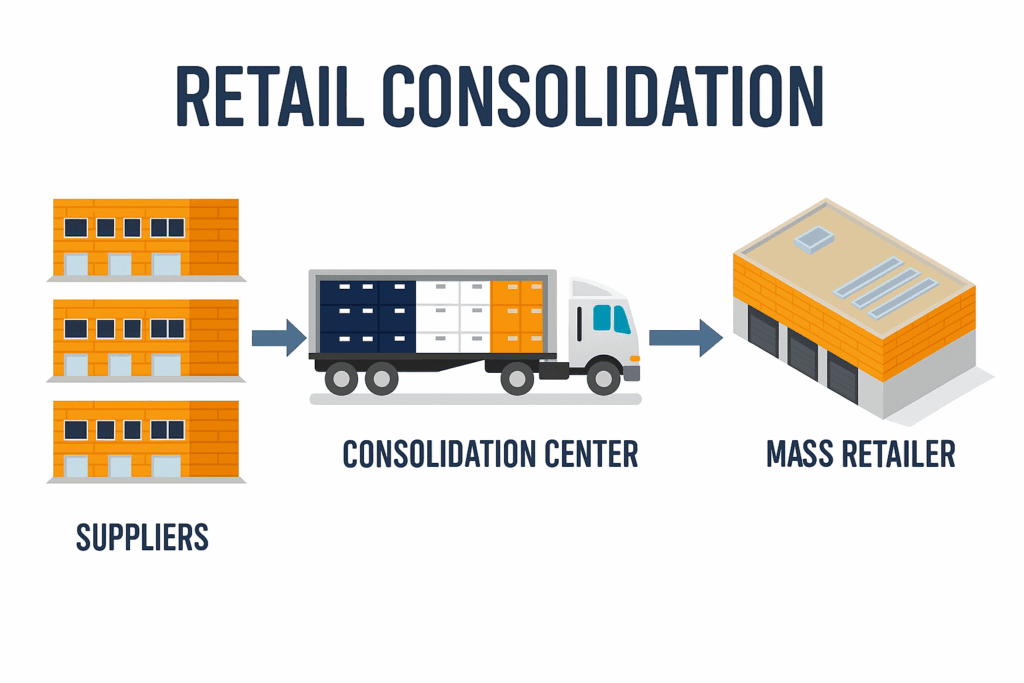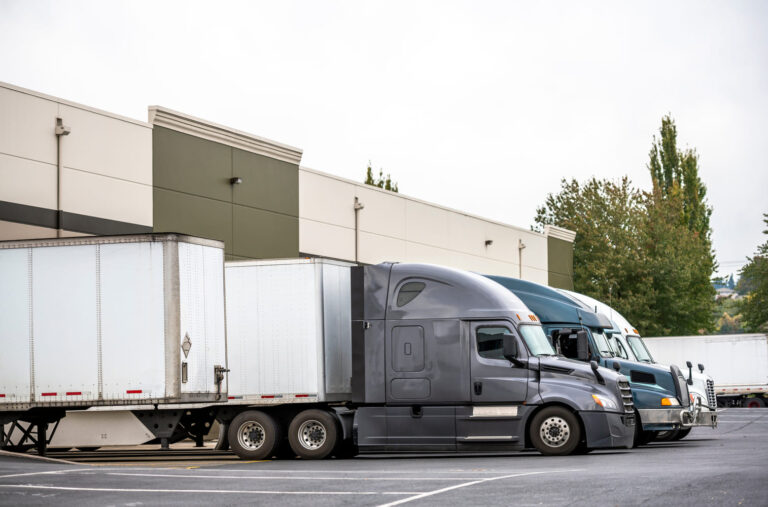Retail Consolidation Services: The Complete Guide to Cost Savings and OTIF Compliance

Retail consolidation is a logistics strategy that groups multiple small shipments for the same retailer into one larger truckload. Instead of sending many underfilled LTL (less-than-truckload) loads, suppliers pool their goods to form consolidated full truckloads. This approach leverages economies of scale – sharing truck space to one retail center – and dramatically cuts per-unit freight costs. It also simplifies compliance with strict retailer delivery requirements (like OTIF) and improves inventory visibility by merging orders at a central consolidation center.
What Is Retail Consolidation?
At a consolidation center or hub, smaller shipments from various vendors (often including importers) are combined into full truckloads bound for the retailer. By routing goods through such consolidation centers, companies fill trucks more efficiently, reduce empty space, and save money. In practice, major 3PLs “bundle products from multiple suppliers and LTL shipments into full truckloads” for delivery to retail distribution centers, cutting transit time and costs.

Benefits of Retail Consolidation Services
Retail consolidation offers several strategic advantages for shippers and suppliers. When done right, it delivers measurable gains in cost, compliance, and efficiency. Key benefits include:
1. Lower Freight Costs
By maximizing trailer space and eliminating underutilized LTL shipments, businesses significantly reduce their cost per unit. Full truckload consolidation allows multiple suppliers to share transportation costs to a common retailer, often resulting in 20–30% savings compared to standard LTL rates. The higher the trailer utilization, the greater the financial efficiency.
2. Improved Compliance and On-Time Delivery
Retailers today demand strict adherence to delivery schedules, particularly with OTIF (On Time In Full) requirements. Consolidation services are designed to meet these standards by optimizing routing, scheduling, and documentation. This leads to greater delivery reliability, fewer penalties, and stronger retail partnerships.
3. Better Inventory Management
Retail consolidation often includes shared warehousing and centralized freight handling. This improves inventory visibility, reduces overstock, and supports faster replenishment. By staging products at regional hubs or cross-dock facilities, suppliers can respond more quickly to retailer demand while minimizing storage costs.
4. Fewer Damages and Claims
Reducing the number of touchpoints between origin and final delivery greatly lowers the risk of product damage, shipment errors, or missing items. Consolidated shipments typically involve fewer transfers and handling steps, which improves claims ratios and overall shipment integrity.
5. Environmental Benefits
Consolidation reduces the number of trucks on the road, directly decreasing fuel usage and carbon emissions. By pooling shipments into fewer, fuller loads, companies not only save money but also align with sustainability goals and ESG commitments. This greener approach is increasingly valued by both retailers and consumers.
Types of Retail Consolidation Strategies
Retailers and importers can use different consolidation methods to suit their needs. The two main strategies are Retail Order Consolidation and Retail Inventory Consolidation, with a related method called LTL Consolidation/Pool Distribution.
Retail Order Consolidation
This method combines multiple small shipments headed to the same retailer into one full truckload. Shipments from various suppliers are sent to a consolidation center where they are pooled and reloaded into a single trailer. This cuts per-shipment fees and transportation costs, since each supplier pays only for their truck space. Order consolidation is highly efficient for meeting retailer windows and avoids sending many individual LTL deliveries.
Retail Inventory Consolidation
Here, different vendors’ inventory is stored together in a single warehouse or distribution center. Having a shared inventory pool enables better load planning and faster fulfillment. For example, suppliers send their goods to a common warehouse; orders are then built into full loads more efficiently. This strategy improves trailer utilization and speeds up deliveries to stores or distribution centers by ensuring trucks leave fuller.
LTL Consolidation and Pool Distribution
LTL consolidation or pool distribution is a hybrid strategy. Smaller shipments bound for the same region are collected at a regional hub. They are loaded into one truck, shipped together, and then broken out for final local delivery. This reduces transit time and cost per mile. Key benefits of LTL pooling include:
- Lower freight costs through fuller truckloads, sharing the load across shippers.
- Faster, more direct deliveries to the region (all items arrive in one consolidated delivery instead of multiple stops).
- Reduced damage risk due to fewer handling steps.
- Simplified tracking: only one tracking number is needed for the consolidated load.
- Less environmental impact from fewer total miles driven.
These consolidation methods let retailers and importers ship smarter while meeting tight delivery demands with speed and accuracy.
Choosing the Right Retail Consolidation Solution
1. Partner with an Experienced Transportation Provider
Look for a proven leader in retail consolidation, particularly one with expertise in serving major retailers. A provider familiar with your industry or your retail partners can minimize friction and streamline coordination. Ensure they offer end-to-end solutions, including:
- Intermodal, truckload, and LTL shipping
- Cross-docking and final-mile delivery
- Deep knowledge of capacity constraints and timing requirements
2. Demand Advanced Technology & Real-Time Visibility
In logistics, visibility equals control. Your ideal partner should leverage:
- Modern Warehouse (WMS) & Transportation Management (TMS) Systems
- Real-time shipment tracking (GPS, IoT sensors, automated updates)
- Digital documentation to reduce errors and delays
- Data analytics for forecasting and route optimization
3. Verify a Strong Compliance Track Record
Retailers impose strict delivery windows, unloading protocols, and inspection requirements. A reliable consolidator must demonstrate:
- Consistent on-time performance
- Expertise in retailer-specific guidelines (e.g., Walmart, Target, Amazon)
- Operational discipline to avoid costly chargebacks
4. Optimize Trailer Utilization for Cost Efficiency
The core value of consolidation lies in maximizing space and minimizing waste. The right partner should:
- Combine shipments from multiple vendors/locations to reduce empty trailer space
- Minimize unnecessary handling for faster, more efficient deliveries
- Lower freight costs through smarter load planning
5. Ensure Strategic, Scalable Execution
True consolidation success depends on end-to-end planning, not just logistics. Seek a provider that offers:
- Demand forecasting & volume planning
- Scalable solutions to grow with your business
- Full supply chain visibility from origin to final delivery
Is Retail Consolidation Right for You?
Consolidation can offer big savings and service improvements, but it works best under certain conditions. Retail consolidation may be a good fit if:
- You regularly ship multiple small loads to large retailers.
- You want to lower freight costs and avoid LTL fees.
- Your suppliers can meet consolidated shipment schedules.
It might not make sense if:
- You already ship efficiently in full truckloads.
- Your suppliers frequently miss delivery windows.
In short, consolidation helps when you have enough volume and predictability to fill shared loads and need better on-time performance.
Need help navigating retail consolidation?
Explore how OLIMP Warehousing Solutions can connect you to retail-savvy 3PLs, cross-docking facilities, and consolidation programs that work.
Frequently Asked Questions (FAQ) – OLIMP Warehousing
Q: What is LTL consolidation?
Combining multiple smaller shipments into one truckload at a central hub, so shippers each pay only for their space—reducing costs and maximizing truck utilization.
Q: What is pool distribution, and how is it different from LTL?
Pool distribution consolidates shipments destined for the same region into one trailer, which is then deconsolidated locally—typically involving fewer shippers than traditional LTL.
Q: What are the main benefits of settling on pooling?
Key benefits include lower shipping costs, fewer handling steps (less damage risk), shorter transit time, and reduced carbon emissions.
Q: When is pooling or consolidation worthwhile?
When you ship frequently to a specific region, have enough volume to fill shared loads, and want cost-reductions plus operational reliability.
Q: How does the pooling process work?
Shipments are pooled at the origin, loaded onto a shared trailer, shipped to a regional hub, sorted by destination, then delivered via local LTL.
You may be interested in

Full Truckload (FTL) Shipping Services: How It Works, Costs & Use Cases
Full truckload shipping (FTL) is a freight transport mode where one shipper’s cargo occupies an entire truck trailer. In FTL service – also known as FTL trucking or full truckload freight transport – a carrier dedicates a 48′ or 53′ trailer exclusively to one shipment. Unlike less-than-truckload (LTL) shipping (where freight from multiple shippers shares […]

Dock-to-Dock Delivery: A Comprehensive Guide
Dock-to-dock delivery means shipping goods straight from one loading dock to another with no intermediate stops. In other words, a shipment is picked up at the origin dock and delivered directly to the destination dock, bypassing extra handling or storage. This direct approach cuts out delays and extra labor – making deliveries faster, cheaper, and […]

What Is Transloading? Definition, Services & Facilities Guide
Transloading moves cargo between trucks, trains and ships to cut costs and speed delivery. It means unloading freight from one mode (like a ship’s container) and reloading it onto another (such as a freight train or trailer). This process lets importers and shippers mix modes – using rail or ocean for long hauls and trucks […]
Ready to streamline your warehousing needs?
Request a quote today and discover how OLIMP's tailored solutions can optimize your operations